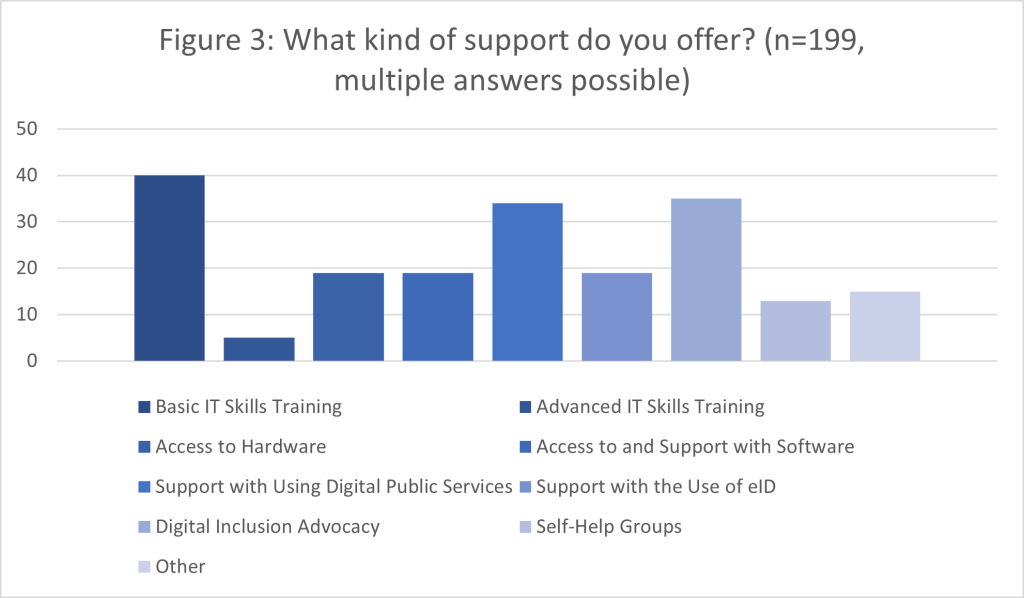In today’s highly digitized society, the concept of digital inclusion is often celebrated as a means to bridge societal gaps. However, more is to be done to render digitalization a tool that serves every part of the society equally.
While the Nordic and Baltic countries rank high in international assessments of digital inclusion, there are still marginalized groups facing significant barriers. To shed light on this pressing issue, we launched a survey to map civil society actors working on digital inclusion across the region.
We contacted more than 300 organisations with the goal to map civil society actors engaged in digital inclusion. Through desk-research, support from our reference group as well as representatives of the Nordic Council of Ministers’ Offices in the Baltic countries, we gained valuable insights from across the Nordic-Baltic Region. The reference group of our Digital Inclusion in Action project consists of public servants working with various aspects of digitalisation in the eight countries and three autonomous territories in the region.
Digital Exclusion poses a problem across population groups
The survey, available in multiple languages, yielded responses from 73 NGOs representing different population groups at risk of digital exclusion: older adults, rural communities, young people, people with disabilities, low income or low education and immigrants (see our project’s pre-study: Monitoring Digital Inclusion in the Nordic-Baltic region).
While these organisations were primarily selected based on their work with the seven target groups listed above – rather than their involvement with digital inclusion – a clear picture emerged. 93% of the organisations that responded confirmed that they deem their respective target group to be at risk of digital exclusion; meaning, groups in society that aren’t using or fully benefiting from public and private digital services.
While the seven identified target groups were quite evenly represented by the responding organisations, grassroot organisations and other NGOs working with older adults and people with disabilities stood out slightly. Groups brought up under the category “Other” were women, people with drug addictions and homeless people.

Causes of digital exclusion are manifold
TThe majority of respondents highlighted lack of basic IT skillsas a main hurdle to digital inclusion (57 replies, see Figure 2). Other prominent obstacles were “fear and mistrust” with 35 replies and “no access to digital devices” with 29 replies. Poorly designed digital solutions, lack of multilingual services or limited access to digital services for people without a local social security number were mentioned as additional aspects by the respondents in the comment field.

These insights confirm the complexity of digital exclusion and the lived reality for many people in the Nordic-Baltic Region when trying to access (certain) digital services. Despite good performance in international digitalisation rankings such as the EU’s Digital Economy and Society Index (DESI) or the UN’s e-Government Survey, the Nordic and Baltic countries are still missing groups that require additional support in order to take part in our highly digitised society. As these marginal experiences tend to get overlooked in the public debate, it is important to highlight these experiences and explore the work being done by civil society actors. Of the 73 organisations surveyed, 61 replied that they offer support to overcome the challenges of digital exclusion. The support they offer ranges from basic IT skills training over digital inclusion advocacy on a political level to support in the use of digital public services:

What’s next?
This survey provided a first glance at the challenges and solutions that the civil society sector in the Nordic and Baltic countries, alongside the three autonomous territories, is working with when it comes to digital inclusion and exclusion.
In the next step, we will interview a selection of NGOs to learn more about their role as enablers of digital inclusion, their best practices and their lessons learned so far. This shall support the project’s goal to unearth remaining shortcomings, particularly on a policy level. It shall also help to foster collaboration across the region, establishing a platform for knowledge exchange and shared learning.
The distribution of civil society actors working with digital inclusion, identified by this survey, will further be integrated in a mapping tool that will soon be available on Nordregio’s DigiHub. This tool will evolve throughout the project, and will serve as a resource for people in search of support with overcoming digital exclusion issues, as well as to visualise geographical areas in need of strengthened efforts to reach digital inclusion in the future.
With each step, we strive to shine a light on the challenges and solutions in digital inclusion across the Nordic-Baltic Region. By amplifying the voices of civil society actors and fostering collaboration, we are working towards a more inclusive and equitable digital landscape for all.